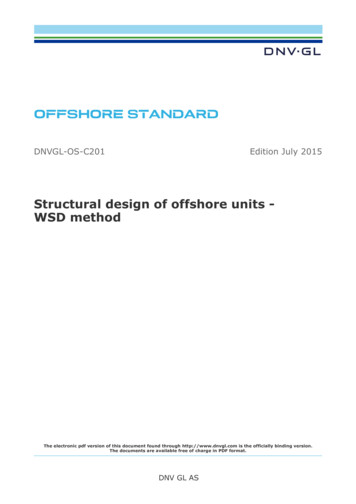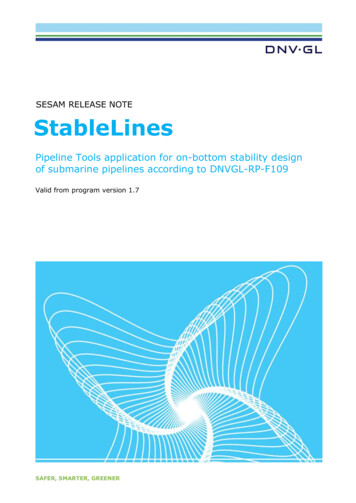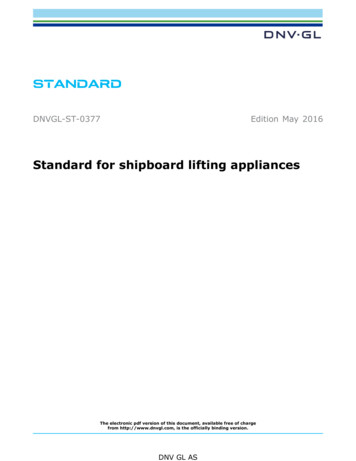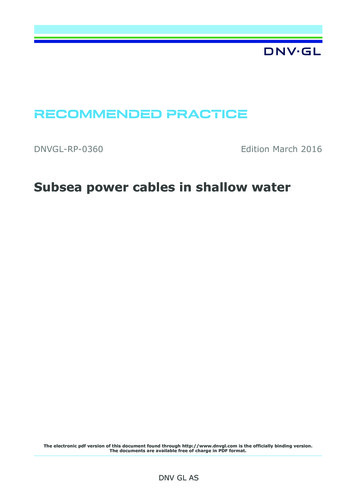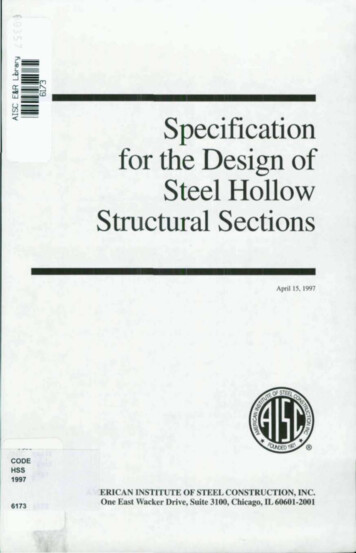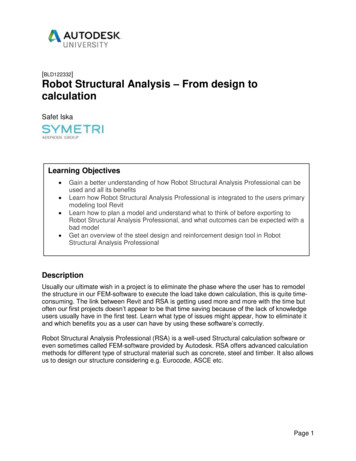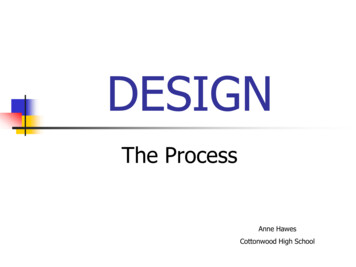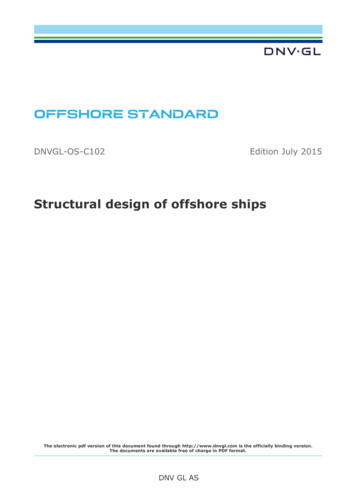
Transcription
OFFSHORE STANDARDDNVGL-OS-C102Edition July 2015Structural design of offshore shipsThe electronic pdf version of this document found through http://www.dnvgl.com is the officially binding version.The documents are available free of charge in PDF format.DNV GL AS
FOREWORDDNV GL offshore standards contain technical requirements, principles and acceptance criteria related toclassification of offshore units. DNV GL AS July 2015Any comments may be sent by e-mail to rules@dnvgl.comThis service document has been prepared based on available knowledge, technology and/or information at the time of issuance of this document. The use of thisdocument by others than DNV GL is at the user's sole risk. DNV GL does not accept any liability or responsibility for loss or damages resulting from any use ofthis document.
GeneralThis document supersedes DNV-OS-C102, October 2014.Text affected by the main changes in this edition is highlighted in red colour. However, if the changesinvolve a whole chapter, section or sub-section, normally only the title will be in red colour.On 12 September 2013, DNV and GL merged to form DNV GL Group. On 25 November 2013 Det NorskeVeritas AS became the 100% shareholder of Germanischer Lloyd SE, the parent company of the GL Group,and on 27 November 2013 Det Norske Veritas AS, company registration number 945 748 931, changed itsname to DNV GL AS. For further information, see www.dnvgl.com. Any reference in this document to “DetNorske Veritas AS”, “Det Norske Veritas”, “DNV”, “GL”, “Germanischer Lloyd SE”, “GL Group” or any otherlegal entity name or trading name presently owned by the DNV GL Group shall therefore also be considereda reference to “DNV GL AS”.Main changes July 2015 GeneralThe revision of this document is part of the DNV GL merger, updating the previous DNV standard into a DNVGL format including updated nomenclature and document reference numbering, e.g.:— Main class identification 1A1 becomes 1A.— DNV replaced by DNV GL.— DNV-RP-A201 to DNVGL-CG-0168. A complete listing with updated reference numbers can be found onDNV GL's internet.To complete your understanding, observe that the entire DNV GL update process will be implementedsequentially. Hence, for some of the references, still the legacy DNV documents apply and are explicitlyindicated as such, e.g.: Rules for Ships has become DNV Rules for Ships. Ch.2 Sec.1 Material selection and fabrication principles— [3.2.6] Included specification of length for topside module. Ch.2 Sec.2 Design principles— [1.1.3]: A reference to arrangement of water tight bulkheads given in DNV Rules for ships Pt.3 Ch.1Sec.3 A is included— [2.6] New guidance note clarifying benign waters criteria wrt use of characteristic wave bendingmoment. Ch.2 Sec.3 Design loads— [3.8] Including definitions of sagging and hogging in guidance note. Ch.2 Sec.4 Strength of hull structure— [2.2.8] Rewritten clause in line with original intention.— [5.5.5] Rewritten clause in line with original intention.— Table 7: Permissible peak stress for the LRFD method limited to the material tensile stress. Ch.2 Sec.5 Strength of topside structures— Table 3 Removed previous column c) as ALS is not a required design condition for topside structure.Editorial correctionsIn addition to the above stated main changes, editorial corrections may have been made.Offshore standard, DNVGL-OS-C102 – Edition July 2015Structural design of offshore shipsDNV GL ASPage 3Changes – currentCHANGES – CURRENT
CHANGES – CURRENT . 3CH. 1 INTRODUCTION . 9Sec.1General . 91General .91.1 Introduction.91.2 Objectives .91.3 Scope and applications .92Definitions .102.1 Verbal forms . 102.2 Terms . 102.3 Symbols . 112.4 Abbreviations . 112.5 References . 12CH. 2 TECHNICAL PROVISIONS . 13Sec.1Sec.2Sec.3Material selection and fabrication principles . 131Introduction .132Selection of material.132.1 General . 132.2 Design and service temperatures . 132.3 Hull structure . 142.4 Topside structure and elements not covered by the DNV Rules for ships. 143Fabrication principles .163.1 General . 163.2 Topside structure and topside interface to hull structure . 164Corrosion addition .174.1 General . 174.2 Offshore specific tanks . 17Design principles. 181Introduction .181.1 Overall design principles . 182Design conditions .182.1 General . 182.2 Transit condition. 182.3 Operating conditions . 182.4 Survival condition (ULS) . 192.5 Accidental condition (ALS) . 192.6 Benign waters or harsh environmental areas . 192.7 Wave load analysis . 203Design methods .223.1 General . 223.2 Working stress design method . 223.3 Load and resistance factor design method. 23Design loads. 241Introduction .241.1 General . 24Offshore standard, DNVGL-OS-C102 – Edition July 2015Structural design of offshore shipsDNV GL ASPage 4ContentsCONTENTS
Sec.4Sec.5Static loads .242.1 General . 242.2 Still water hull girder loads . 243Environmental loads .253.1 General . 253.2 Wave induced loads . 253.3 Wind loads. 253.4 Green sea. 263.5 Sloshing loads in tanks . 263.6 Bottom slamming . 273.7 Bow impact. 273.8 Combination of dynamic loads . 273.9 Design density of tanks . 29Strength of hull structure . 311Introduction .312General technical requirements .312.1 Overview . 312.2 Girder system . 313Hull3.13.23.34Local supports .355Local stress analysis .355.1 Application. 355.2 General . 375.3 Analysis model . 375.4 Design loading condition . 375.5 Fine mesh criteria . 37girder longitudinal strength (ULS).33General . 33Design loading conditions . 33Hull girder capacity . 34Strength of topside structures . 391Application .391.1 General . 391.2 Definition of load point . 402Local static loads on topside structures .403Local requirements to plates and stiffeners .413.1 Plates (local design). 413.2 Stiffeners (local design). 414Requirements to simple girders (primary design) .424.1 General . 424.2 Strength assessment . 425Complex girder system .435.1 General . 435.2 Strength assessment . 436Global assessment of topside structure .446.1 General . 446.2 Strength assessment . 457Acceptance criteria .467.1 Usage factors . 467.2 Local liquid tanks. 467.3 Buckling control. 46Offshore standard, DNVGL-OS-C102 – Edition July 2015Structural design of offshore shipsDNV GL ASPage 5Contents2
Sec.6Sec.7Sec.8Sec.9Fatigue control . 47Topside interface to hull structure . 481Application .482Strength assessment .482.1 Requirements to the FE model. 482.2 Design load. 482.3 Load combination . 482.4 Acceptance criteria . 492.5 Fatigue . 49Fatigue . 501Principles and methodology.501.1 General . 501.2 Assessment principles . 501.3 Methods for fatigue capacity . 501.4 Fatigue details to be considered. 501.5 Design loads and calculation of stress range. 511.6 Design fatigue factor . 511.7 Details to be checked . 512Advanced fatigue methodology.532.1 Introduction. 532.2 Principles. 53Accidental conditions . 561Introduction .561.1 General . 562Accidental scenarios .562.1 Dropped objects . 562.2 Fires . 562.3 Explosions . 562.4 Unintended flooding . 572.5 Collision . 572.6 Loss of heading control. 572.7 Heeled condition. 57Welding and weld connections . 581Introduction .581.1 General requirements. 582Size2.12.22.32.42.5of welds .58Double continuous fillet welds . 58Fillet welds and deep penetration welds subject to high tensile stresses . 59Full penetration welds . 59End connection of stiffeners . 59Direct calculations . 59Sec.10 Special provisions for drilling units . 611Introduction .612Design principles .612.1 General . 613Strength assessment .613.1 General . 613.2 Green sea loads . 613.3 Design loading conditions . 613.4 Fatigue . 61Offshore standard, DNVGL-OS-C102 – Edition July 2015Structural design of offshore shipsDNV GL ASPage 6Contents7.4
Fabrication principles .624.1 Hull structure . 624.2 Topside and topside support structure . 625Corrosion control .625.1 Hull and topside structure . 62Sec.11 Special provisions for floating production,storage and offloading units . 631Introduction .632Design principles .632.1 General . 633Strength assessment .633.1 General . 633.2 Green sea loads . 643.3 Design loading conditions . 643.4 Fatigue strength . 643.5 Hull support structure for mooring system . 663.6 Bilge keel . 673.7 Loading instrument . 674Fabrication principles .675Corrosion control .685.1 Hull structure . 685.2 Topside structure. 68CH. 3 CLASSIFICATION . 69Sec.1Classification services . 691General .691.1 Introduction. 691.2 Application. 691.3 Documentation. 69APP. A CONVERSION OF TANKER TO FLOATING OFFSHOREUNIT . 701Introduction .701.1 General . 702Strength .702.1 General . 702.2 Benign waters operation . 702.3 Basis requirements . 712.4 Hull girder longitudinal strength. 712.5 Topside and topside interface to hull structure . 713Fatigue .723.1 General . 723.2 Previous trade. 723.3 Operation . 723.4 Areas to be checked . 723.5 Mean stress effect . 733.6 Documentation. 733.7 Environmental reduction factors . 73Offshore standard, DNVGL-OS-C102 – Edition July 2015Structural design of offshore shipsDNV GL ASPage 7Contents4
1Introduction .761.1 General . 761.2 Survey extent . 762Structural strength .762.1 General . 763Fatigue .763.1 General . 763.2 Previous trades . 763.3 Operation . 763.4 Areas to be checked. 773.5 Mean stress effect . 773.6 Documentation. 77Offshore standard, DNVGL-OS-C102 – Edition July 2015Structural design of offshore shipsDNV GL ASPage 8ContentsAPP. B LIFETIME EXTENSION OF FLOATING OFFSHOREUNITS. 76
SECTION 1 GENERAL1 General1.1 Introduction1.1.1 This standard comprises sections with provisions applicable to Floating Production and/or StorageUnits (FSO/FPSO) and Drillships.1.1.2 This standard describes both the Working Stress Design (WSD) method and the Load and ResistanceFactor Design (LRDF) method. The design principle method should be used consequently through the wholeproject. The design methods are described in [3.2] and [3.3] respectively.1.2 ObjectivesThe objectives of this standard are to:— provide an internationally acceptable standard for design of offshore ship-shaped units— serve as a technical reference document in contractual matters between purchaser and manufacturer— serve as a guideline for designers, purchaser, contractors and regulators— provide, as far as possible, consistent loads for both topside and hull design.1.3 Scope and applications1.3.1 This standard is applicable to hull and topside of ship-shaped offshore units, such as drilling unitsand floating production/storage units, constructed in steel for both non-restricted and restricted operations.1.3.2 This standard covers the following structural items:— material selection and fabrication principles— design principles— design loads— ultimate strength requirements— fatigue requirements— specify procedures and requirements for units subject to DNV GL classification services.1.3.3 Serviceability (SLS) condition is not covered in this standard.1.3.4 The hull girder longitudinal strength principles are based on site specific environmental loads.1.3.5 For application of this standard as technical basis for classification see Ch.3.1.3.6 Flag and shelf state requirements are not covered by this standard.Guidance note:Governmental regulations may include requirements in excess of the provisions of this standard depending on the type, location andintended service of the offshore unit or installation. The 100 year return period is used to ensure harmonisation with typical ShelfState requirements and the code for the construction and equipment of mobile offshore drilling units (MODU Offshore standard, DNVGL-OS-C102 – Edition July 2015Structural design of offshore shipsDNV GL ASPage 9Chapter 1 Section 1CHAPTER 1 INTRODUCTION
2.1 Verbal formsTable 1 Verbal formsTermDefinitionshallverbal form used to indicate requirements strictly to be followed in order to conform to the documentshouldverbal form used to indicate that among several possibilities one is recommended as particularly suitable,without mentioning or excluding others, or that a certain course of action is preferred but not necessarilyrequiredmayverbal form used to indicate a course of action permissible within the limits of the document2.2 Terms2.2.1 Standard terms are given in DNVGL-OS-C101.Table 2 TermsTermDefinitiondrilling unita unit used for drilling in connection with exploration and/or exploitation of oil and gasThe unit is generally operating on the same location for a limited period of time and isnormally equipped with dynamic positioning system with several thrusters. The unit followsthe normal class survey program.floating production andoffloading unita unit used for the production of oil with arrangement for offloading to a shuttle tankerfloating storage andoffloading unita unit used for storage of oil with arrangement for offloading to a shuttle tankerfloating production,storage and offloadingunita unit used for the production and storage of oil with arrangement for offloading to a shuttletankerThe units normally consist of a hull, with turret or spread mooring arrangement, andproduction facilities above the main deck. The unit can be relocated, but is generally locatedon the same location for a prolonged period of time.The units normally consist of a hull, with turret or spread mooring system. The unit isequipped for crude oil storage. The unit can be relocated, but is generally located on thesame location for a prolonged period of time.The unit is equipped for crude oil storage. The unit is normally moored to the seabed withproduction facilities on the main deck. The unit can be relocated, but is normally located onthe same location for a prolonged period of time.floating production,drilling, storage andoffloading unita unit used for drilling, storage and production of oil with arrangement for offloading to ashuttle tankerLNG/LPG floatingproduction and storageunitsa unit with facilities for oil and gas production and storageThe unit is equipped for crude oil storage.The unit is typically permanently moored. Due to the complexity of the unit morecomprehensive safety assessment are typically carried out. The unit is normally equippedwith solutions for quick disconnection of mooring lines between the shuttle tanker and theoil and gas producing and storage unit.turreta device providing a connection point between the unit and the combined riser- andmooring- systems, allowing the unit to freely rotate (weather vane) without twisting therisers and mooring lines.temporary mooringanchoring in sheltered waters or harbours exposed to moderate environmental loadsstructural de
Offshore standard, DNVGL-OS-C102 – Edition July 2015 Page 3 Structural design of offshore ships DNV GL AS CHANGES – CURRENT Changes – current Ge
